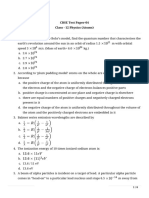Midterm 1
Uploaded by
cebuano88Midterm 1
Uploaded by
cebuano88Physics 3313, Midterm I (1) The structure of the unit cell for a mineral called perovskite is shown below.
(a) Assuming the cubic lattice with a=6 A, what are the volume densities of Ti, Ca, and O atoms? (b) A variety of perovskite called dysanalyte has the Ti atoms replaced by Nb (niobium) atoms. If the density (mass of a unit volume) is the same for both minerals, what is the ratio of their lattice constants? The respective atomic weights are Ca:40, O:16, Ti:48, and Nb:93.
Ca (calcium) O (oxigen) Ti (titanium)
(2) A system of non-interacting particles in an innite potential well in the ground state (n = 1) is illuminated by light. At certain wavelengths, the system absorbs the light due to elevation of particles to higher energy levels. (a) If the ground state energy E1 =1 eV, light of which wavelength will elevate the particles to the n = 2 energy level? (b) In the 300700 nm range, the experiment detected two absorption lines: 1 =330.7 nm and 2 =620 nm. What is the ground state energy? Hint: to simplify the calculations, you can use the fact that photon energy in eV is 1240 related to its wavelength in nm as E (eV) = . (nm) (3) The conduction and valence bands in a semiconductor can be described as Ec (k) = E1 E2 cos ka and Ev (k) = E3 + E4 cos2 ka, respectively, where E1 =6 eV, E2 =1 eV, E3 =3.5 eV, E4 =0.5 eV, a=2 A. What is the hole to electron mass ratio? (4) The distribution of electrons in a semiconductor is described by the Fermi-Dirac probability function. The probability to nd an electron with energy 8 eV at T =300 K is the same as the probability to nd an electron with energy 9 eV at T =600 K. What is the Fermi energy (assuming that it does not depend on temperature)?
You might also like
- Hourglass Workout Program by Luisagiuliet 276% (21)Hourglass Workout Program by Luisagiuliet 251 pages
- The Hold Me Tight Workbook - Dr. Sue Johnson100% (16)The Hold Me Tight Workbook - Dr. Sue Johnson187 pages
- Read People Like A Book by Patrick King-Edited62% (65)Read People Like A Book by Patrick King-Edited12 pages
- Livingood, Blake - Livingood Daily Your 21-Day Guide To Experience Real Health77% (13)Livingood, Blake - Livingood Daily Your 21-Day Guide To Experience Real Health260 pages
- COSMIC CONSCIOUSNESS OF HUMANITY - PROBLEMS OF NEW COSMOGONY (V.P.Kaznacheev,. Л. V. Trofimov.)94% (212)COSMIC CONSCIOUSNESS OF HUMANITY - PROBLEMS OF NEW COSMOGONY (V.P.Kaznacheev,. Л. V. Trofimov.)212 pages
- Donald Trump & Jeffrey Epstein Rape Lawsuit and Affidavits83% (1016)Donald Trump & Jeffrey Epstein Rape Lawsuit and Affidavits13 pages
- The 36 Questions That Lead To Love - The New York Times94% (34)The 36 Questions That Lead To Love - The New York Times3 pages
- The 36 Questions That Lead To Love - The New York Times95% (21)The 36 Questions That Lead To Love - The New York Times3 pages
- Jeffrey Epstein39s Little Black Book Unredacted PDF75% (12)Jeffrey Epstein39s Little Black Book Unredacted PDF95 pages
- The 4 Hour Workweek, Expanded and Updated by Timothy Ferriss - Excerpt23% (954)The 4 Hour Workweek, Expanded and Updated by Timothy Ferriss - Excerpt38 pages
- Sheet1 Atomic Structure and Bonding SoluNo ratings yetSheet1 Atomic Structure and Bonding Solu11 pages
- Molecules and Condensed Matter: Modern Physics MA in Teaching College PhysicsNo ratings yetMolecules and Condensed Matter: Modern Physics MA in Teaching College Physics44 pages
- 3413EM-Physics Study Material Chap-8-14.compressed - Compressed PDFNo ratings yet3413EM-Physics Study Material Chap-8-14.compressed - Compressed PDF88 pages
- III The Sommerfeld Free Electron Theory of Metals 2000 Solid State PhysicsNo ratings yetIII The Sommerfeld Free Electron Theory of Metals 2000 Solid State Physics25 pages
- XI-Chemistry-DOE Support Material 2019-20 - 2No ratings yetXI-Chemistry-DOE Support Material 2019-20 - 222 pages
- 172441-NCERT-Solutions-Class-9-Science-Chapter-4-Structure-Of-The-Atom-PDFNo ratings yet172441-NCERT-Solutions-Class-9-Science-Chapter-4-Structure-Of-The-Atom-PDF12 pages
- CHAPTER 3: Electrons in Atoms: 3.1 Sub-Shells and Atomic Orbitals 3.2 Electronic Configuration 3.3 Ionisation EnergyNo ratings yetCHAPTER 3: Electrons in Atoms: 3.1 Sub-Shells and Atomic Orbitals 3.2 Electronic Configuration 3.3 Ionisation Energy12 pages
- Max Plank:: Learning Objectives For This ChapterNo ratings yetMax Plank:: Learning Objectives For This Chapter4 pages
- Electron Energy in Solids: Schroedinger's EquationNo ratings yetElectron Energy in Solids: Schroedinger's Equation21 pages
- Chapter1 Basics of Semiconductor Physics PDF100% (2)Chapter1 Basics of Semiconductor Physics PDF48 pages
- CHM131 - CH 3 - The Electronic Structure of Atoms and Periodic Table PDF100% (1)CHM131 - CH 3 - The Electronic Structure of Atoms and Periodic Table PDF102 pages
- Section 11 - Methods - For - Calculating - Band - Structure PDFNo ratings yetSection 11 - Methods - For - Calculating - Band - Structure PDF9 pages
- Electron Beam-Specimen Interactions and Simulation Methods in MicroscopyFrom EverandElectron Beam-Specimen Interactions and Simulation Methods in MicroscopyNo ratings yet
- Ever Smaller: Nature's Elementary Particles, From the Atom to the Neutrino and BeyondFrom EverandEver Smaller: Nature's Elementary Particles, From the Atom to the Neutrino and BeyondNo ratings yet
- University of California Diversity StatementNo ratings yetUniversity of California Diversity Statement1 page
- The Supplemental Nutrition Assistance Program: Categorical EligibilityNo ratings yetThe Supplemental Nutrition Assistance Program: Categorical Eligibility19 pages
- City of Little Rock 2012 Solid Waste Services Holiday ScheduleNo ratings yetCity of Little Rock 2012 Solid Waste Services Holiday Schedule2 pages
- Supplemental Nutrition Assistance Program: How Can My Family Eat Better?No ratings yetSupplemental Nutrition Assistance Program: How Can My Family Eat Better?4 pages
- Illinois River Sub-Basin and Eucha-Spavinaw Lake Watershed InitiativeNo ratings yetIllinois River Sub-Basin and Eucha-Spavinaw Lake Watershed Initiative2 pages











































































































